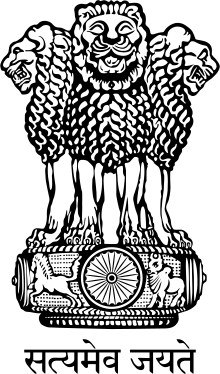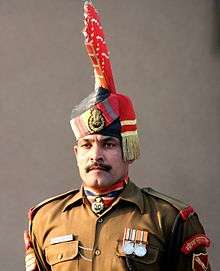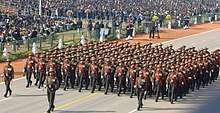Central Armed Police Forces
The Central Armed Police Forces (CAPF) refers to uniform nomenclature of security forces in India under the authority of Ministry of Home Affairs. Their role is to defend the national interest mainly against the internal threats. They are the Border Security Force (BSF), Central Reserve Police Force (CRPF), Central Industrial Security Force (CISF), Indo-Tibetan Border Police (ITBP) and National Security Guard (NSG)[2] and Sashastra Seema Bal (SSB).[3][4][5]
| Central Armed Police Forces | |
|---|---|
 | |
| Abbreviation | CAPF |
| Agency overview | |
| Annual budget | ₹920 billion (US$13 billion) (2020–2021)[1] |
| Jurisdictional structure | |
| Federal agency | IN |
| Operations jurisdiction | IN |
| Governing body | Ministry of Home Affairs |
| General nature | |
| Operational structure | |
| Minister responsible | |
| Agency executive |
|
| Parent agency | Ministry of Home Affairs |
| Child agencies | |
| Website | |
| Official Website | |

Organisation and leadership
Central Armed Police Forces are organized with the primary role of border guarding for BSF, ITBP, SSB; Security of sensitive establishments by CISF, Assisting Police to tackle Law & Order, Counter-Terrorist Operations, Counter Naxal Operations by CRPF, NSG. Apart from the primary role, all CAPFs are involved in assisting Police in Law & Order situations and also Army in Counter-Terrorist Operations. BSF & CRPF have assisted the army during external aggression in the past. CAPFs work along with both Army & Police in different roles assigned to them.
Central Armed Police Forces personnel also serve in various important organisations such as Research and Analysis Wing (RAW), Special Protection Group (SPG), National Investigation Agency (NIA), Intelligence Bureau (IB), Central Bureau of Investigation (CBI), National Disaster Response Force (NDRF), Narcotics Control Bureau (NCB) and Indian Army on deputation. Their role and performance, therefore, assumes a great significance due to the special features of an emergency force which is pressed in aid to the civil power to perform multiple roles in extremely difficult situations.
Organized Group ‘A’ Service (OGAS) to Group ‘A’ Executive Cadre Officers
Supreme Court Ruling
On 5 February 2019, the Supreme Court of India ruled[6][7] that all CAPFs would be granted better pay benefits or Non-Functional Financial Upgradation (NFFU),[8] and the status of Organised Group ‘A’ Services (OGAS), ending a nearly decade-long battle for the central armed police. In a landmark judgment by Justices Rohinton Fali Nariman and M R Shah, the court said the CAPF officers–from BSF, CRPF, SSB, ITBP, and CISF– will now be granted the NFFU and will be considered as organized group A Central Services.
Approval By Cabinet
In July 2019, Union Cabinet granted[9][10] Organized Group 'A' Service (OGAS) status to Group 'A' executive cadre officers of the Central Armed Police Forces (CAPF). It also extended the benefit of Non-Functional Financial Upgradation(NFFU) and Non-Functional Selection Grade (NFSG) to the executive cadre officers at an enhanced rate of 30%.
Recruitment, ranks and structure
Recruitment of candidates to the CAPFs may be conducted by the Union Public Service Commission, the Staff Selection Commission, or the respective service HQs depending on the post to be filled. There are three possible pathways for recruitment to the CAPFs:
Gazetted officers
Officers in CAPFs are recruited through the Central Armed Police Forces (Assistant Commandants) Examination conducted by UPSC. They are appointed as Assistant Commandants and are Gazetted Officers generally referred to as DAGOs (Directly Appointed Gazetted Officers) in CRPF, AC (Direct Entry) in BSF. DEGOs (Departmental Entry Gazetted Officers) are those officers who have been promoted through departmental exams conducted internally for Subordinate Officers.
| CAPFs ranks | Police ranks | Army ranks | Navy ranks | Air Force ranks | Coast Guard ranks |
|---|---|---|---|---|---|
| Director General (Apex Scale) | Director General of State Police Force | Lieutenant General | Vice Admiral | Air Marshal | Director General |
| Additional Director General (ADG) | Additional Director General (ADG) | Lieutenant General | Vice Admiral | Air Marshal | Additional Director General |
| Inspector General (IG) | Inspector General (IG) | Major General | Rear Admiral | Air Vice Marshal | Inspector General |
| Deputy Inspector General (DIG) | Deputy Inspector General (DIG) | Brigadier | Commodore | Air commodore | Deputy Inspector General |
| Commandant | Senior Superintendent of Police (SSP) | Colonel | Captain | Group Captain | commandant |
| Second-in-Command | Superintendent of Police (SP) | Lt.Colonel | Commander | Wing Commander | commandant (Jr grade). |
| Deputy Commandant | Additional Deputy Commissioner of Police/Additional Superintendent of Police | Major | Lieutenant Commander | Squadron Leader | Deputy Commandant |
| Assistant Commandant | Assistant Commissioner of Police (ACP) / Deputy Superintendent of Police (DSP) | Captain | Lieutenant | Flight lieutenant | Assistant Commandant |
Subordinate officers
Sub Inspectors are recruited through competitive examination conducted by Staff Selection Commission and they are referred to as DASOs (Directly Appointed Subordinate Officers). DESOs (Departmental Entry Subordinate Officers) are those officers who have been promoted through departmental exams conducted internally for Constables, Head Constables, and Assistant Sub Inspectors.
Constables
Constables are recruited through a competitive examination conducted by Staff Selection Commission.
Apart from the above modes, CAPFs conduct recruitment for specialized posts such as Engineers, Doctors, etc. among DAGOs and Wireless operators, Technicians, Nursing Staff, etc. among subordinate officers and constables directly under their own authority.

Women in the Central Armed Police Forces
Initially, women were not recruited for the Central Armed Police Forces. In 1992 Asha Sinha created history by being the first Woman Commandant of any of the Central Armed Forces in India when she was selected as Commandant, Central Industrial Security Force, for Mazagon Dock Shipbuilders Limited. Earlier the role of Women was allowed but limited to supervisory roles in the Central Armed Police Forces.[11] The Parliamentary Committees of India for women's empowerment recommended greater roles for women in the CAPF. On these recommendations, the Ministry of Home Affairs declared reservation for women in constabulary in paramilitary forces, and later declared that they can also be inducted as officers in combat roles in all five Central Armed Police Forces.[11] The Union Home Minister announced that women's representation in the CRPF and CISF would be made 15 percent while it would be 5 percent in the BSF, ITBP and SSB.[12] On 5 January 2016, it was decided that 33 percent of posts at the constabulary level would be reserved for women in the CRPF and the CISF to begin with, and 14-15 percent of posts at the constable level in the BSF, SSB and ITBP in a phased manner, Rijiju said. In 2016, an IPS Officer Archana Ramasundaram of 1980 Batch rewrote history when she became the first woman to become the Director General of Police of a Paramilitary Force as DG, Sashastra Seema Bal.[13]
Central Reserve Police Force (CRPF)
The Central Reserve Police Force is the largest of the Central Armed Police Forces units with 313,678 personnel in 245 battalions.[14] The Central Reserve Police includes:
- The Rapid Action Force (RAF), a 15 battalion anti-riot force trained to respond to sectarian violence.
- The Commando Battalion for Resolute Action (COBRA), a 10 battalion strong anti-Naxalite/COIN force.[15]
Border Security Force (BSF)

The primary role of the Border Security Force is to guard the Indo-Pakistan and Indo-Bangladesh borders, it is deployed both on the international border and the LOC. The BSF also has active roles during times of war. It has 257,363 personnel in 186 battalions.[16]
Central Industrial Security Force (CISF)
One of the largest industrial security forces in the world, the Central Industrial Security Force provides security to various Public Sector Undertakings (PSUs) and other critical infrastructure installations, major airports across the country and provides security during elections and other internal security duties and VVIP protection. It has a total strength of about 144,418 personnel in 132 battalions.[14] including 9 reserve battalions.
Indo-Tibetan Border Police (ITBP)
The Indo-Tibetan Border Police is deployed for guarding duties on the Indo-China border from Karakoram Pass in Ladakh to Diphu Pass in Arunachal Pradesh covering a total distance of 3488 km.[17] It has 89,432 personnel in 56 fighting, 2 DM and 4 specialized battalions.[18][14]
Sashastra Seema Bal (SSB)
The objective of the Sashastra Seema Bal (English: Armed Border Force) is to guard the Indo-Nepal and Indo-Bhutan borders. It has 76,337 personnel and 67 battalions, as well as some reserved battalions.[19][14][20]
Assam Rifles (AR)

The Assam Rifles can trace their lineage back to a paramilitary police force that was formed under the British in 1835 called Cachar Levy. Since then the Assam Rifles have undergone a number of name changes before the name Assam Rifles was finally adopted in 1917.[21] Over the course of its history, the Assam Rifles and its predecessor units have served in a number of roles, conflicts, and theatres including World War I where they served in Europe and the Middle East, and World War II where they served mainly in Burma. In the post World War II period the Assam Rifles has expanded greatly as has its role. There are currently 63,747 personnel and 46 battalions[22] of Assam Rifles under the control of the Indian Ministry of Home Affairs (MHA) and they perform many roles including the provision of internal security under the control of the army through the conduct of counter insurgency and border security operations, provision of aid to the civil power in times of emergency, and the provision of communications, medical assistance and education in remote areas.[23] In times of war, they can also be used as a combat force to secure rear areas if needed.
National Security Guard (NSG)
The National Security Guard (NSG) is a counter terrorism unit under the Ministry of Home Affairs (MHA). It was raised on 15 October 1984, following Operation Blue Star, Akshardham Temple attack and the assassination of Indira Gandhi, "for combating terrorist activities with a view to protect states against internal disturbances". Currently it has 7,350 personnel.[24]
See also
UPSC CAPF Syllabus,How to prepare,Notification,what books to use complete guide==References==
- "MHA gets 1.67 lakh crore;emphasis on police,census".
- "Central Armed Police Forces | Ministry of Home Affairs | GoI". mha.gov.in. Retrieved 13 February 2020.
- "Central Armed Police Forces | Ministry of Home Affairs | GoI". mha.gov.in. Retrieved 20 January 2020.
- "Organizational Structure of the Central Armed Police Forces". Archived from the original on 10 August 2019.
- "Pay more for paramilitary deployment: MHA to states". The Economic Times. 11 October 2019. Retrieved 20 January 2020.
- https://indianexpress.com/article/india/sc-upholds-hc-order-on-nffu-for-capf-officers-5571027/
- https://main.sci.gov.in/supremecourt/2013/7829/7829_2013_Judgement_05-Feb-2019.pdf
- https://dopt.gov.in/sites/default/files/14017_47_2011-Estt.RR-01082012.pdf
- https://pib.gov.in/PressReleaseIframePage.aspx?PRID=1576843
- https://www.business-standard.com/article/news-ani/centre-gives-nods-to-grant-ogas-status-to-group-a-executive-cadre-officers-119070301021_1.html
- "Government allows women to be combat officers in all Central Armed Police Forces". The Economic Times. 11 July 2018. Retrieved 9 January 2020.
- "Women quota in CRPF, CISF to be made 15 percent". www.telegraphindia.com. Retrieved 9 January 2020.
- Selvaraj, A. "Archana Ramasundram becomes first woman to head paramilitary forces | India News - Times of India". The Times of India. TNN. Retrieved 9 January 2020.
- "MHA Annual Report 2016-2017" (PDF). Archived from the original (PDF) on 8 August 2017.
- "COBRA to sting Naxal virus: new force gets Centre nod". Financial Express. 29 August 2008. Retrieved 26 February 2014.
- "Border Security Force". bsf.nic.in. Archived from the original on 20 August 2014. Retrieved 19 February 2020.
- "Indo-Tibetan Border Police". Archive.india.gov.in. Retrieved 9 February 2014.
- "Home | Indo Tibetan Border Police, Ministry of Home Affairs". itbpolice.nic.in. Retrieved 10 August 2017.
- "Guarding the Nation's Frontiers | eGov Magazine". Egov.eletsonline.com. 6 March 2013. Retrieved 5 January 2014.
- "Force Profile- SSB Ministry Of Home Affairs, Govt. Of India". ssb.nic.in. Retrieved 12 August 2017.
- The Assam Frontier Police (1883), the Assam Military Police (1891) and Eastern Bengal and Assam Military Police (1913), before finally becoming the Assam Rifles in 1917. See Sharma 2008.
- See History of the Assam Rifles Archived 10 March 2009 at the Wayback Machine
- Sharma 2008.
- "Wayback Machine" (PDF). 4 March 2016. Archived from the original (PDF) on 4 March 2016. Retrieved 19 February 2020.
External links
| Wikimedia Commons has media related to Central Armed Police Forces. |